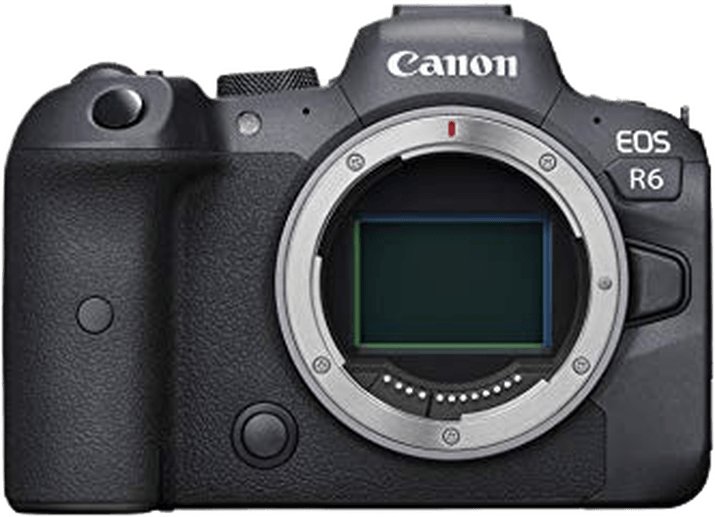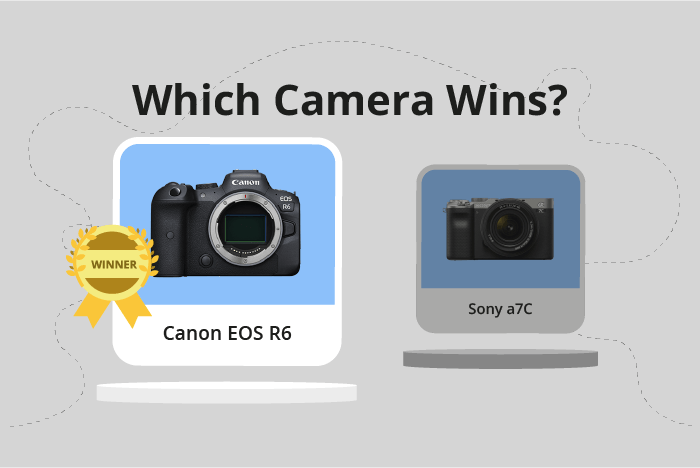Canon EOS R6 vs Sony a7C Comparison
Canon EOS R6

Sony a7C

The Canon EOS R6 takes the lead with a score of 80/100, while the Sony a7C trails closely behind at 78/100. Both cameras are mirrorless and were released in 2020, with the R6 being announced in August and the a7C in November. They share similar features, but the R6 has a higher launch price of $2499 compared to the a7C’s $1799.
The Canon EOS R6 is the better camera due to its superior performance and features, justifying its higher score. It is larger and heavier, measuring 138 x 98 x 88mm and weighing 680g.
On the other hand, the Sony a7C has its advantages, such as being more compact and lightweight, measuring 124 x 71 x 60mm and weighing 509g. This makes it more portable and easier to handle for some users.
Taking everything into account, the Canon EOS R6 offers more advanced features and performance, while the Sony a7C provides a more compact and lightweight option. Both cameras have their merits, and the choice ultimately depends on the user’s preferences and needs.
Canon EOS R6 vs Sony a7C Overview and Optics
The Sony a7C wins in optics with a score of 80/100, while the Canon EOS R6 scores 79/100. Both cameras share several specifications, including a CMOS sensor, full-frame sensor size, and image stabilisation. They also have different lens mounts, with the Canon EOS R6 using the Canon RF mount and the Sony a7C utilising the Sony FE mount.
The Sony a7C excels with a higher resolution of 24.2 megapixels compared to the Canon EOS R6’s 20.1 megapixels, which provides more detailed images. Additionally, the Sony a7C boasts a higher DXOMARK score of 95 for its sensor, indicating better overall image quality than the Canon EOS R6’s score of 90.
On the other hand, the Canon EOS R6 outperforms the Sony a7C in shooting speed, capturing images at a rapid 20 fps while the Sony a7C reaches only 10 fps. This advantage makes the Canon EOS R6 better suited for fast-paced photography, such as sports and wildlife.
Furthermore, the Canon EOS R6 houses a more advanced Digic X processor, which can enhance the camera’s performance and responsiveness compared to the Sony a7C’s Bionz X processor. This difference may lead to faster autofocus, better noise reduction, and quicker image processing.
Both cameras exhibit strengths in various aspects, with the Sony a7C winning in resolution and sensor quality, while the Canon EOS R6 excels in shooting speed and processing power. Ultimately, the choice between these two cameras depends on the user’s specific needs and preferences.
Canon EOS R6 vs Sony a7C Video Performance
The Canon EOS R6 outperforms the Sony a7C in video capabilities, scoring 91 out of 100, while the Sony a7C scores 70. Both cameras share some common features, such as a 4K maximum video resolution and 3840 x 2160 video dimensions. They also both have built-in time-lapse functionality.
The Canon EOS R6 takes the lead with its maximum video frame rate of 120fps, which is significantly higher than the Sony a7C’s 30fps. This higher frame rate allows for smoother and more detailed slow-motion footage, providing better creative options for videographers. The R6’s higher video score reflects its superior performance in this area.
On the other hand, the Sony a7C does not have any distinct advantage over the Canon EOS R6 in video capabilities. Both cameras share similar features, but the a7C falls short in the video frame rate department. This lower frame rate limits the flexibility and potential for capturing fast-action scenes or creating smooth slow-motion effects.
Considering the video features of both cameras, the Canon EOS R6 stands out as the better choice for videographers due to its higher frame rate, providing more options for creative video production. The Sony a7C, while still offering 4K resolution and time-lapse functionality, does not match the R6’s performance in video capabilities. Therefore, those prioritizing video quality and versatility should opt for the Canon EOS R6 over the Sony a7C.
Canon EOS R6 vs Sony a7C Features and Benefits
The Canon EOS R6 outperforms the Sony a7C with a feature score of 85/100 compared to the latter’s 81/100. Both cameras share several specifications, including a 3-inch screen size, touchscreen capabilities, flip screens, and the absence of GPS. Additionally, both cameras have Wi-Fi and Bluetooth connectivity.
The Canon EOS R6 excels due to its higher screen resolution of 1,620,000 dots, providing a more detailed and clearer image preview. This advantage allows users to better assess their shots and make necessary adjustments before capturing an image.
On the other hand, the Sony a7C still offers decent features despite its lower score. With a screen resolution of 921,600 dots, it delivers adequate image previews for most users. However, the difference in screen resolution may not be significant enough to impact the overall user experience, especially for casual photographers.
In terms of shared features, both cameras cater to the needs of various users, such as vloggers and content creators, with their flip screens and touchscreen capabilities. Wi-Fi and Bluetooth connectivity further enhance user experience by enabling easy sharing and remote control of the cameras.
When deciding between the Canon EOS R6 and the Sony a7C, one should consider their specific needs and preferences. The Canon EOS R6 holds a slight advantage in terms of screen resolution, but both cameras offer a range of useful features. Ultimately, the choice depends on individual priorities and requirements.
Canon EOS R6 vs Sony a7C Storage and Battery
The Canon EOS R6 outperforms the Sony a7C in storage and battery with a score of 68/100, compared to the Sony a7C’s 45/100. Both cameras accept SD, SDHC, and SDXC memory cards (UHS-II compatible) and offer USB charging.
The EOS R6 has a clear advantage with its two memory card slots, doubling the storage capacity and offering more flexibility for photographers. However, the Sony a7C boasts a longer battery life of 740 shots, significantly surpassing the EOS R6’s 360 shots per charge. This extended battery life is beneficial for extended shoots or situations with limited access to power sources.
While the Canon EOS R6 provides superior storage options, the Sony a7C offers a more enduring battery life. Users should consider their specific needs and preferences when choosing between these two cameras.
Canon EOS R6 vs Sony a7C – Our Verdict
Are you still undecided about which camera is right for you? Have a look at these popular comparisons that feature the Canon EOS R6 or the Sony a7C:

